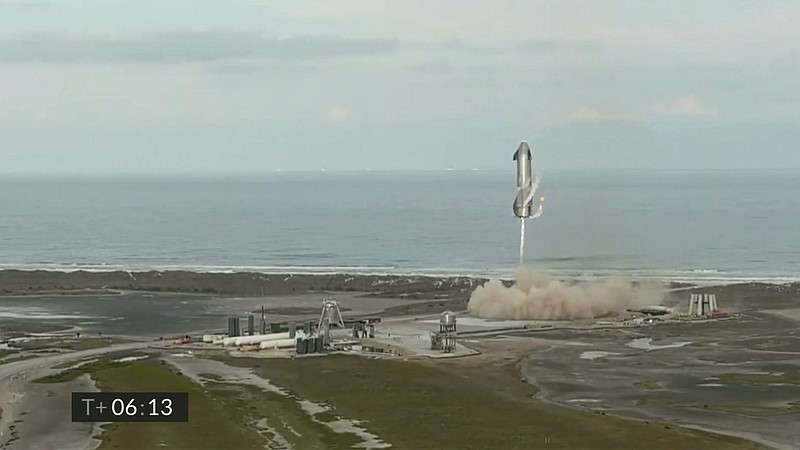SpaceX's futuristic Starship aced a touchdown Wednesday, but then exploded on the landing pad with so much force that it was hurled into the air.
The blast occurred just minutes after SpaceX declared success. Two previous test flights crash-landed in fireballs.
"The key point of today's test flight was to gather the data on controlling the vehicle while reentering," SpaceX commentator John Insprucker said on SpaceX's webcast of the test. "And we were successful in doing so."
The full-scale prototype of Elon Musk's envisioned Mars ship soared more than 6 miles using three of the company's Raptor engines after lifting off Wednesday from the southern tip of Texas.
The rocket shut off each engine in succession as it reached its target altitude, then turned onto its belly for a horizontal descent controlled by two forward and two aft flaps, all run by an on-board computer. It then flipped upright just in time to land.
[Video not showing up above? Click here to watch » https://www.youtube.com/watch?v=dEoYM7xXMno]
The shiny bullet-shaped rocket remained intact this time at touchdown, prompting Insprucker to declare, "third time's a charm as the saying goes" before SpaceX ended the webcast.
As the smoke cleared, SN10 was still standing, but tilted. The landing legs appeared to fail, leaving the rocket standing but leaning at the landing pad.
Then the Starship exploded and was tossed in the air, before slamming down into the ground in flames.
Musk looked on the bright side in a tweet: "Starship 10 landed in one piece! RIP SN10, honorable discharge."
He added: "SpaceX team is doing great work! One day, the true measure of success will be that Starship flights are commonplace."
The SN10 performed its maneuvers just as well as the SN9 and SN8 rockets, but excelled at the landing where the two previous ended up exploding during their flights in December and February.
Wednesday's launch was the second attempt of the day. Three hours earlier, liftoff was aborted with just a fraction of a second left in the countdown. The engines had already ignited but were then shut off when the computer on board the Starship detected too much thrust from one of the engines. The engineers decided that the problem was not significant, adjusted the software, refueled the rocket and tried again.
The company will continue with its prototype series of tests with SN11 soon to line up for its own flight.
Plans are for SpaceX to continue proving out flight ability for Starship with higher altitudes, and eventually orbital test flights. The tests follow a similar method it used when developing its Falcon rockets. Starship is the company's eventual replacement for its Falcon 9 and Falcon Heavy rockets.
The Starship design is meant to be used for both suborbital point-to-point flights on Earth and for deep-space missions such as to the moon and Mars. The full version is designed to feature six Raptor engines, stand about 165 feet tall and have a 100-passenger capacity. The large version of Starship would be coupled with a Super Heavy booster with 37 Raptor engines combined for Mars colonization plans.
Musk's company-- full name Space Exploration Technologies Corp. -- has become successful in the launch business, and it is now one of the world's most valuable privately held companies. Its Falcon 9 rockets have become a dominant workhorse for sending satellites to orbit. It routinely transports cargo to the International Space Station and lifted NASA astronauts there twice in 2020, with more trips planned this year.
However, many are skeptical about Musk's assertion that the company is just a few years from sending a Starship to Mars, saying he has repeatedly set timelines for SpaceX that proved far too optimistic in how quickly they have come to pass.
In 2019, when he provided an update on the development of Starship, he said a high-altitude test would occur within months and that orbital flights could occur early in 2020.
Instead, several catastrophic failures happened because of faulty welding. When the propellant tanks stopped rupturing, two of the prototypes made short, successful flights last year.
In a video released Tuesday night, Musk said Starship would be ready to launch people to orbit and beyond by 2023. He made the remarks in a video released by Yusaku Maezawa, a Japanese entrepreneur who is helping to financially underwrite the development of Starship. Maezawa intends to fly on a weeklong trip around the moon and back to Earth.
Information for this article was contributed by Marcia Dunn of The Associated Press; by Richard Tribou of The Orlando Sentinel (TNS); and by Kenneth Chang of The New York Times.
